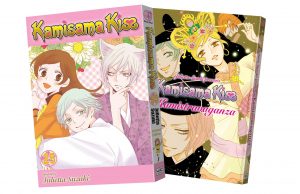Kamisama Kiss Volume 25 Limited Edition by Julietta Suzuki
I had a good time getting caught up on this series in order to enjoy the special edition concluding volume. After having to deal with the grand conclusion of the saga concerning Tomoe and Akura-ou, including visiting the land of the dead, tracking down Akura-oh’s immortal body, and dealing with Nanami’s decline after having her life force taken from her, the final volume gives all the characters in Kamisama Kiss some much needed breathing room, as Nanami and Tomoe prepare to enter the world of human adulthood together. Along the way Nanami helps out the Kotaro and Himemiko one last time, and it is nice to have this circular moment of returning to some of Nanami’s first friends after she became attached to the Ayakashi world.
Nanami and Tomoe’s wedding is a little bittersweet, because when they both become human, they’ll become cut off from the world where all their friends live. This is especially hard on Mizuki, who is worried about being left alone. Nanami and Tomoe decide to marry on the last possible day before becoming human, so everyone can be invited to the wedding. I do enjoy final volumes that allow the reader to say goodbye to an extended cast of characters, and this volume pulls off the reunion and celebration in a lively fashion, with detailed wedding costumes and panels that pause to show all the wedding guests. Someone as capable and arrogant as Tomoe isn’t going to have too much difficulty fitting into the human world, and the final chapter shows just how capable the newly human couple is at adapting to their new life.
The limited edition featured a slim hardcover book with the first few pages devoted to small reproductions of the color pages in the manga volumes. This was done in a collage, year-book style layout which was nice, but it also made me really long for an oversized volume of Julietta Suzuki illustrations because some of the detail was lost. The bulk of the volume is an extra bonus story that shows more of Nanami and Tomoe’s life after becoming human, with bonus pencil sketches of the final chapter of the manga. It was nice to get a window into Suzuki’s artistic process, I only wish the special bonus book had been two times the size and twice as long, but I shouldn’t be greedy! Kamisama Kiss was such a special series, I’m glad the final volume got a little extra bonus for the long-time fans who have enjoyed the series for so long.




Recent Comments